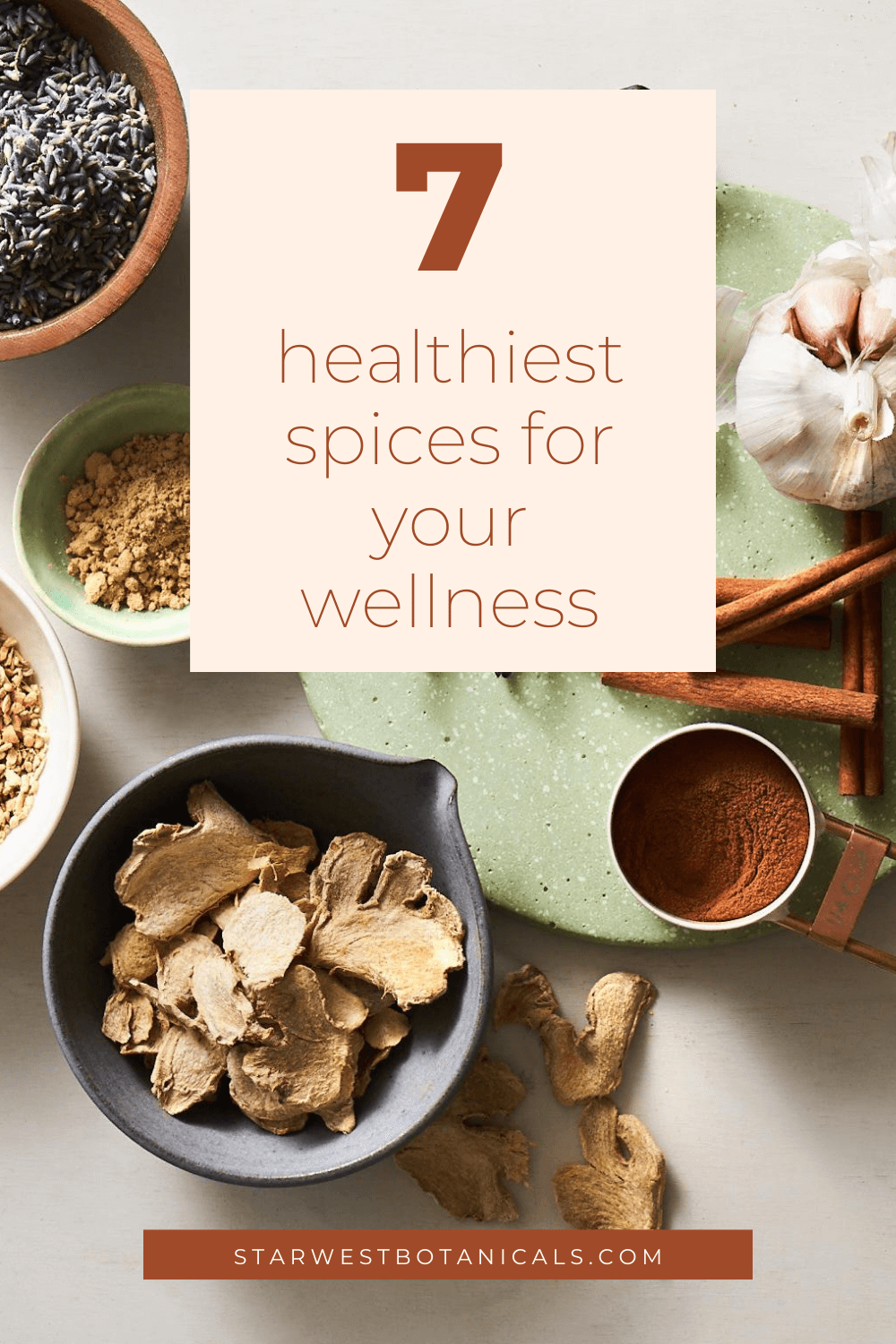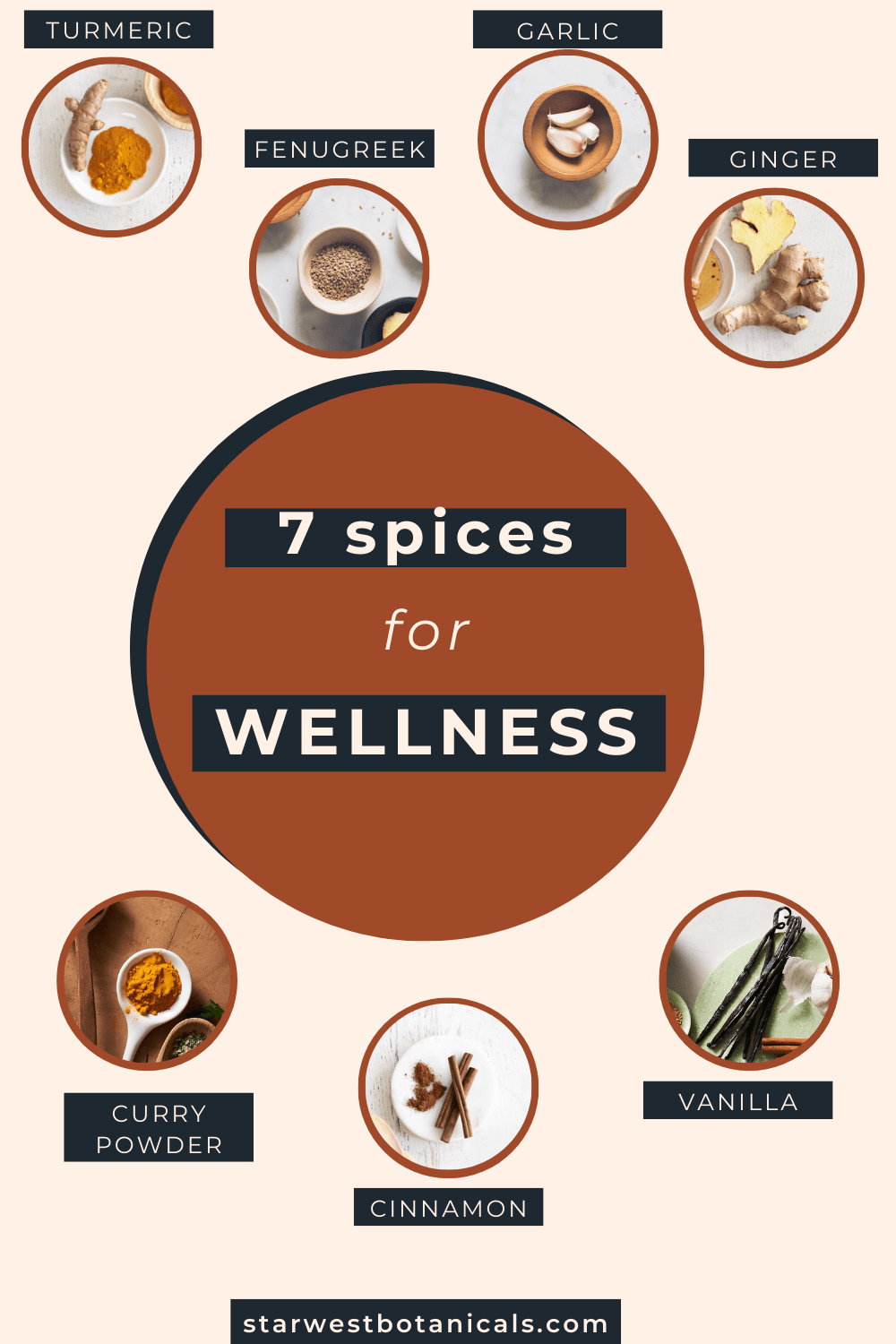7 of the Healthiest Spices for Wellness
Posted by Starwest Botanicals Content Team | Medically Reviewed by Daniel Powers, MS on 07-06-2022

7 Of the Healthiest Spices for Your Wellness
Crafting your signature vindaloo curry or apple cinnamon muffins requires one thing to truly stand out—spices, and lots of them. Spices jam-pack your favorite dishes with mouthfuls of flavors, but they may also have some pretty impressive health benefits.
More specifically, some spices are chock full of health-boosting antioxidants.
If you want to incorporate more flavor in your cooking and you’re looking to boost your overall wellness with some tasty seasonings, you’ve come to the right place. With so many bulk spices online to choose from, narrowing down your spice rack can get a little overwhelming. This guide will walk you through spice basics and answer what are the healthiest spices?
Where Do Spices Come From?
Spices have been used for many purposes for well over 4,000 years. If you remember your history classes, you probably learned about the spice trade and how it contributed to the foundation of many empires and shaped our current geo-politics.
Basically, what we’re saying is that spices are a big deal.
Spices come from all over the world and can be sourced from many plant parts, including:
- Seeds – Spices that come from seeds are either ground into powder or used whole, depending on the purpose. Common seed spices include pepper, cardamom, mustard, nutmeg, anise, and vanilla.
- Leaves or Flowers – Other spices begin as leaves or flowers. This could be an herb either used whole or dried and ground into powders or pastes. These types of spices include mint, basil, bay leaf, oregano, and curry leaf.
- Roots, Stems, and Bark – Other spices are made out of the harder, woodier parts of plants. These are typically dried and ground into a flavorful powder. Some spices you may be familiar with include cinnamon, horseradish, ginger, turmeric, and lemongrass.
What Are Spices Used For?
The main use of most spices is flavoring food. However, some spices make appearances in other roles, including:
- Medicinal oils
- Essential oils
- Cleaning products
- Body lotions, soaps, and shampoo
When eaten, they may also help to boost your overall health and wellness.

The Healthiest Herbs and Spices
Evidence indicates that some of the healthiest seasonings are also the tastiest. Let’s break down the usage and potential benefits of seven spices that may already be in your cabinet, and how you can use them to elevate your meals and your health
#1 Turmeric
Turmeric belongs to the same plant family as ginger. Its bright yellow-orange color is luminous and it contains a critical health-boosting compound called curcumin, which contains:
- Antioxidant properties
These two traits make turmeric a potentially powerful wellness tool since inflammation and oxidative damage are both linked to poor health. Fortunately, adding a dash of turmeric to your morning smoothie or mixing it into your carrot bread may help to keep you feeling healthy and strong.
How to Use Turmeric
If you’re looking to add this golden spice to your everyday healthy cooking, consider the following options:
- Indian curries
- Chicken and fish dishes
- Golden milk tea
- Mustards or butters
You can learn more about how we source our turmeric here at Starwest Botanicals here.
#2 Fenugreek
Fenugreek is a spice commonly used in Indian, Iranian, Egyptian, and Moroccan cuisine. It’s said to have a flavor profile similar to maple syrup.
How to Use Fenugreek
Fenugreek is often found in curry powders and other spice mixes used in Indian dishes. It can be used to make:
- Pickles
- Chutneys
- Dressings
- Sauces
#3 Garlic
Have you ever walked into a kitchen where someone has just tossed some garlic into a sauté pan? The heavenly aroma immediately makes your mouth water. If you love adding garlic to your savory dishes, you might be benefiting your taste buds and your health.
All of these possible benefits are the result of a compound found in members of the allium family—allicin. This compound is present in garlic, onions, chives, leeks, and more.
How to Use Garlic
If you’re part of team garlic, you already know that garlic enhances the flavor of just about any savory dish. You can add garlic to:
- Marinades
- Sauces
- Dressings
- Soups and stews
- Stir fry
Garlic is truly one of the most flexible and delicious spices.
#4 Ginger
If you’ve ever purchased ginger root from the produce section of your grocery store, you know that beneath that ugly, knobby appearance lies a spicy, complexly flavored flesh. Ginger can be used in sweet and savory dishes. Dried, powdered ginger also provides that same flavor punch with a little less work on your part.
Research shows that ginger may help reduce nausea and gastrointestinal discomfort like an upset stomach.
How to Use Ginger
The warm, spicy flavor of ginger makes it ideal for many different dishes. Some of our favorite ways to use ginger include:
- Marinades
- Baked goods
- Stir fry
- Curries
Some people also enjoy adding powdered ginger to smoothies for a spicy flavor boost
#5 Curry Powder
Curry powder isn’t a single spice. Rather, it’s a spice blend used to flavor curries and other dishes. Often, curry powders contain some of the following spices:
- Turmeric
- Ginger
- Garlic
- Cumin
- Pepper
- Cardamom
- Fenugreek
- Coriander
Curry powders aren’t just delicious, they come with a potential boost to your body’s inflammatory response and some powerful antioxidants.
How to Use Curry Powder
Curry powders can be slightly sweet and mild, very spicy, and anywhere in between. You can blend them with coconut milk to make curries. They’re also often used as a seasoning for roasted meat, tofu, and vegetables.
#6 Cinnamon
Cinnamon comes from the bark of trees in the Cinnamomum genus. There are two main types of cinnamon—Ceylon and cassia—which each have their own unique flavor profiles:
- Ceylon cinnamon – This variety is known as true cinnamon and originated in Sri Lanka and parts of India. It has a lighter color and is milder in flavor.
- Cassia cinnamon – Also known as Vietnamese or Indonesian cinnamon, these spices are darker in color and have strong, spicy flavor profiles.
Both Ceylon and Cassia cinnamon may provide health benefits, including blood sugar control and antioxidant properties.
How to Use Cinnamon
The most common use of cinnamon is in sweet dishes such as pies, cookies, and cakes. However, it’s also excellent sprinkled atop coffee or mixed into chai tea.
We offer various types of cinnamon here at Starwest Botanicals. Click here to learn how we source our Ceylon cinnamon.
#7 Vanilla
You’ve probably used vanilla extract, either real or imitation, in some of your baked goods. This member of the orchid family is even more flavorful when you use:
- Whole vanilla beans
- Ground vanilla bean powder
Vanilla is rich in the compound vanillin. While further studies are needed, it’s thought that vanillin may have the following properties:
- Antioxidant
- Neuroprotective
Along with these possible health benefits, vanilla provides a rich, sweet flavor to many desserts.
How to Use Vanilla
Vanilla is lovely in cakes, cookies, brownies, pies, muffins, and ice cream. In fact, just about any dessert will benefit from a dash of vanilla.
Shopping for Spices: Our Top Tips
Now that you know which spices are amongst the healthiest, let’s talk about how to shop for them. Fill out that spice rack by:
- Shop Smart – Spices lose their potency over time so you don’t want to buy more than you can use in a reasonable amount of time. If you’re cooking for a small family, opt for small jars when possible and restock your supplies as needed. However, if you’re looking to make large batches of, say, cinnamon cookies or garlic bread, you’ll want to opt for bulk spice batches.
- Store Properly – Spices will last longer when they’re stored in a cool dry place. Moisture may cause your spices to cake up in their jars, making it tough to add them to your recipes.
- Buy Organic – Is it worth buying organic spices? Yes, whenever possible, choose organic or fair trade spices. Since spices come from plants, they can be contaminated by pesticides and herbicides just like your fresh produce. Fair trade spices can help ensure that you’re buying ethically sourced products from the farmers who grow them.
- Try New Spices – Lastly, you should never stop experimenting when cooking. Test out similar spices, such as paprika vs cayenne, or new spices regularly to jazz up your dishes with new flavors and deliver a few health-boosting properties to your body with every bite.
Stock Up On Your Favorite Spices with Starwest Botanicals
Spices are one of the most valuable additions to any kitchen—they enhance the flavor of your favorite foods and may help to support your wellness. Fortunately, healthy spices are both savory and sweet, meaning you can shape every meal around your health.
For an assortment of high-quality organic spices and herbs, add Starwest Botanicals to your shopping list. Our supplies are wholesale and come in bulk batches and small jars and pouches so you have exactly what you need to perfect your recipe and bolster your health.
Be well and stay well with Starwest Botanicals.
Sources:
PubMed. Health Benefits of Culinary Herbs and Spices. https://pubmed.ncbi.nlm.nih.gov/30651162/
U.S. Forest Service. Spices and Herbs. https://www.fs.fed.us/wildflowers/ethnobotany/food/spices.shtml
Britannica. Spices and Herbs. https://www.britannica.com/topic/spice-food


